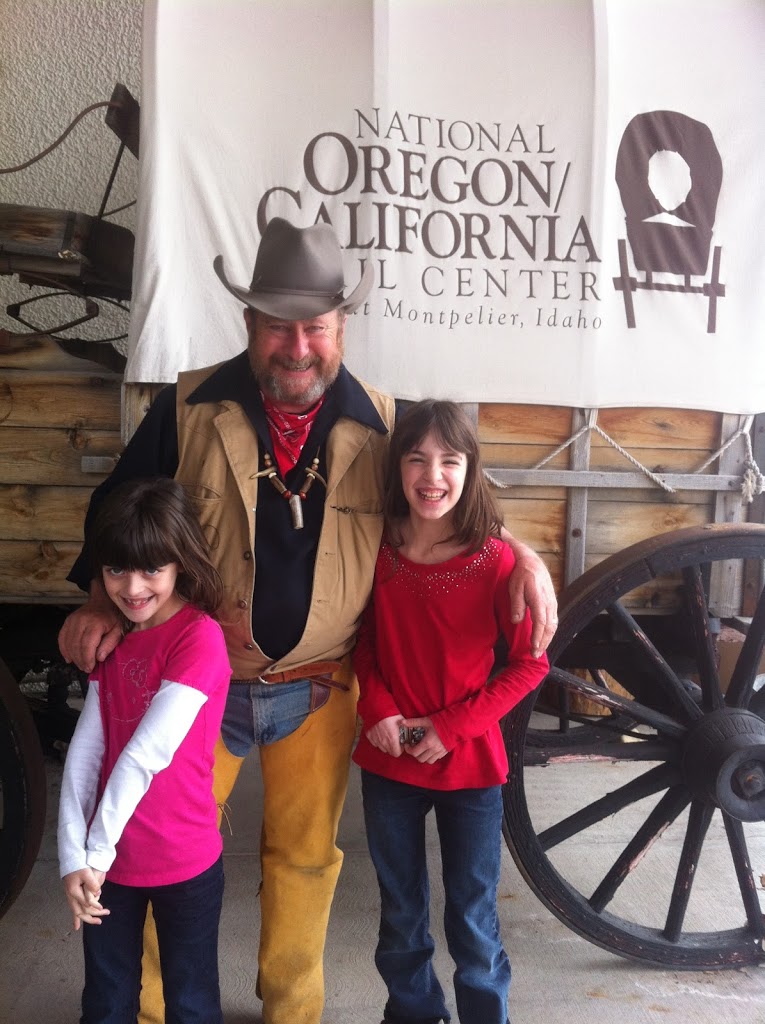As I prepared to write The Journey (originally titled Where the Trail Ends) in 2012, my daughters Karly, Kiki, and I set off from Portland to explore what was left of the Oregon Trail. More than three hundred thousand Americans traveled west on this trail, adults and children alike walking the two thousand miles from Missouri to the Willamette Valley, but the girls and I decided we would drive instead of walk this journey.
My daughters had never joined me for a research trip before, and they enjoyed dressing up like pioneers at the Baker City museum, swimming in Idaho’s hot springs, and taking a simulated wagon ride with a “real” wagon master. The five days of driving? Well, they didn’t enjoy the first day so much, but then their imaginations ignited and they spent the rest of the trip telling stories, enjoying the scenery, and inventing new games. Who knew two kids could spend hours playing with a McDonald’s French fry box? It’s a car…a boat…a plane.

We drove a thousand miles in three days, making it to Wyoming before we turned our “wagon” around. I honestly don’t know how so many families—along with their wagons and livestock—crossed over the raging rivers and towering mountains into Oregon Country. My admiration for these emigrants grew with every mile we drove. The children on the trail worked hard, many of them counting the rotations of a wagon wheel as they walked so the captain could keep track of how far their party had journeyed. Depending on the terrain, they walked ten to twenty miles each day. For six months. Adults would often give children coffee beans to chew so they wouldn’t fall asleep and get injured. Thirty thousand people lost their lives on this arduous journey due to accidents, drowning, and cholera—one grave it is said for every eighty yards of the trail.

The more stories the girls and I heard, the less we complained. After all, our wagon party enjoyed pizza and a swimming pool every night before we slept on a hotel bed. The pioneers spent hours cooking beans and drying bison, but we didn’t even have to get out of our car to buy a Happy Meal.
In 1840, there were only four hundred Americans in Oregon Country and many of those came by sea. It was thought the mountains would be impassable for Americans to cross, but once the first wagons made it across, Americans flooded the land jointly owned by the United States and Great Britain. Most emigrants left their possessions behind in Missouri, trading furniture and household goods for oxen, bacon, molasses, ammunition, cooking stoves, and beans. Some people still attempted to take a piano, headboard, or heavy trunk in their wagon, but those items rarely made it across the mountains. Even though they arrived with little, these resilient Americans tamed the wilderness in this new country and built homes to protect them from the winter rain before they began harvesting the fertile land. In 1859, Oregon became the 33rd state.
Our journey hardly compared with those pioneers who were coming to Oregon for the first time, but still it was a journey none of us will forget. Like those who came before us, we traveled together, ate together, worked together and played together.
It’s that togetherness, perhaps, that helps us do things we never thought possible—like walking two thousand miles to Oregon Country…or writing a novel about those who did. Karly and Kiki wrote a little about our journey as well:

My Oregon Trail Trip by Karly Dobson (age 9)
The first thing I liked about the Oregon Trail was sitting in the car watching the buitiful sunset! It was sooo magestice.
The second thing was watching the cute little prairie dogs running all around Shoshone Falls.
The last thing I liked about the Oregon Trail was of coarse, being with my mom and Kiki.

My Oregon Trail Trip by Kiki Dobson (age 8)
I was on the Oregon Trale and I saw horses. We staed in hotels and I saw cowboys. Last but not lest, I lern that oxen are strong.
 All Rights Reserved © 2024 Melanie Dobson
All Rights Reserved © 2024 Melanie Dobson